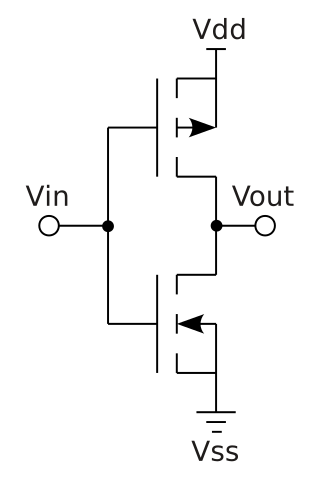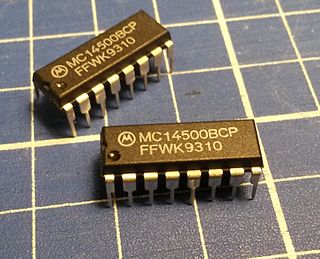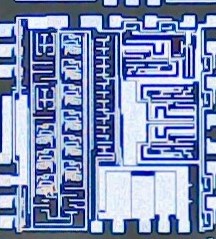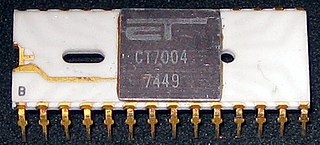
An integrated circuit (IC), also known as a microchip or simply chip, is a set of electronic circuits, consisting of various electronic components and their interconnections. These components are etched onto a small, flat piece ("chip") of semiconductor material, usually silicon. Integrated circuits are used in a wide range of electronic devices, including computers, smartphones, and televisions, to perform various functions such as processing and storing information. They have greatly impacted the field of electronics by enabling device miniaturization and enhanced functionality.

The Zilog Z80 is an 8-bit microprocessor designed by Zilog that played an important role in the evolution of early computing. Launched in 1976, it was designed to be software-compatible with the Intel 8080, offering a compelling alternative due to its better integration and increased performance. In addition to the 8080's seven registers and flags register, the Z80 featured an alternate register set, two 16-bit index registers, and additional instructions, including bit manipulation and block copy/search.

In electronics, the metal–oxide–semiconductor field-effect transistor is a type of field-effect transistor (FET), most commonly fabricated by the controlled oxidation of silicon. It has an insulated gate, the voltage of which determines the conductivity of the device. This ability to change conductivity with the amount of applied voltage can be used for amplifying or switching electronic signals. The term metal–insulator–semiconductor field-effect transistor (MISFET) is almost synonymous with MOSFET. Another near-synonym is insulated-gate field-effect transistor (IGFET).
NMOS or nMOS logic uses n-type (-) MOSFETs to implement logic gates and other digital circuits.

Complementary metal–oxide–semiconductor is a type of metal–oxide–semiconductor field-effect transistor (MOSFET) fabrication process that uses complementary and symmetrical pairs of p-type and n-type MOSFETs for logic functions. CMOS technology is used for constructing integrated circuit (IC) chips, including microprocessors, microcontrollers, memory chips, and other digital logic circuits. CMOS technology is also used for analog circuits such as image sensors, data converters, RF circuits, and highly integrated transceivers for many types of communication.

The 7400 series is a popular logic family of transistor–transistor logic (TTL) integrated circuits (ICs).

Federico Faggin is an Italian-American physicist, engineer, inventor and entrepreneur. He is best known for designing the first commercial microprocessor, the Intel 4004. He led the 4004 (MCS-4) project and the design group during the first five years of Intel's microprocessor effort. Faggin also created, while working at Fairchild Semiconductor in 1968, the self-aligned MOS (metal–oxide–semiconductor) silicon-gate technology (SGT), which made possible MOS semiconductor memory chips, CCD image sensors, and the microprocessor. After the 4004, he led development of the Intel 8008 and 8080, using his SGT methodology for random logic chip design, which was essential to the creation of early Intel microprocessors. He was co-founder and CEO of Zilog, the first company solely dedicated to microprocessors, and led the development of the Zilog Z80 and Z8 processors. He was later the co-founder and CEO of Cygnet Technologies, and then Synaptics.

The MC14500B Industrial Control Unit (ICU) is a CMOS one-bit microprocessor designed by Motorola for simple control applications in 1977.

A mixed-signal integrated circuit is any integrated circuit that has both analog circuits and digital circuits on a single semiconductor die. Their usage has grown dramatically with the increased use of cell phones, telecommunications, portable electronics, and automobiles with electronics and digital sensors.

Mostek Corporation was a semiconductor integrated circuit manufacturer, founded in 1969 by L. J. Sevin, Louay E. Sharif, Richard L. Petritz and other ex-employees of Texas Instruments. At its peak in the late 1970s, Mostek held an 85% market share of the dynamic random-access memory (DRAM) memory chip market worldwide, until being eclipsed by lower-priced Japanese DRAM manufacturers who were accused of dumping memory on the market.

In integrated circuits, depletion-load NMOS is a form of digital logic family that uses only a single power supply voltage, unlike earlier NMOS logic families that needed more than one different power supply voltage. Although manufacturing these integrated circuits required additional processing steps, improved switching speed and the elimination of the extra power supply made this logic family the preferred choice for many microprocessors and other logic elements.

The Centro Nacional de Tecnologia Electrônica Avançada S.A is a Brazilian technology center specialized in project development and fabrication in microelectronics, i.e. integrated circuits, or "chips". This center is one of the agents for the Brazilian Microelectronics Program.
An image sensor or imager is a sensor that detects and conveys information used to form an image. It does so by converting the variable attenuation of light waves into signals, small bursts of current that convey the information. The waves can be light or other electromagnetic radiation. Image sensors are used in electronic imaging devices of both analog and digital types, which include digital cameras, camera modules, camera phones, optical mouse devices, medical imaging equipment, night vision equipment such as thermal imaging devices, radar, sonar, and others. As technology changes, electronic and digital imaging tends to replace chemical and analog imaging.

The U880 is an 8-bit microprocessor that was manufactured by VEB Mikroelektronik "Karl Marx" Erfurt in the German Democratic Republic. Production of the U880 started in 1980 at VEB Funkwerk Erfurt. The U880 is an unlicensed clone of the Zilog Z80 microprocessor, also supporting illegal opcodes and bugs, except for very minor differences like not setting the CY flag for the OUTI command.

Technology computer-aided design is a branch of electronic design automation (EDA) that models semiconductor fabrication and semiconductor device operation. The modeling of the fabrication is termed process TCAD, while the modeling of the device operation is termed device TCAD. Included are the modelling of process steps, and modelling of the behavior of the electrical devices based on fundamental physics, such as the doping profiles of the devices. TCAD may also include the creation of "compact models", which try to capture the electrical behavior of such devices but do not generally derive them from the underlying physics. SPICE simulator itself is usually considered as part of EDA rather than TCAD.

The KR580VM80A is a Soviet microprocessor, a clone of the Intel 8080 CPU. Different versions of this CPU were manufactured beginning in the late 1970s, the earliest known use being in the SM1800 computer in 1979. Initially called the K580IK80 (К580ИК80), it was produced in a 48-pin planar metal-ceramic package. Later, a version in a PDIP-40 package was produced and was named the KR580IK80A (КР580ИК80А). The pin layout of the latter completely matched that of Intel's 8080A CPU. In 1986 this CPU received a new part number to conform with the 1980 Soviet integrated circuit designation and became known as the KR580VM80A (КР580ВМ80А), the number it is most widely known by today. Normal clock frequency for the K580IK80A is 2 MHz, with speeds up to 2.5 MHz for the KR580VM80A. The KR580IK80A was manufactured in a 6 μm process. In the later KR580VM80A the feature size was reduced to 5 μm and the die became 20% smaller.

PMOS or pMOS logic is a family of digital circuits based on p-channel, enhancement mode metal–oxide–semiconductor field-effect transistors (MOSFETs). In the late 1960s and early 1970s, PMOS logic was the dominant semiconductor technology for large-scale integrated circuits before being superseded by NMOS and CMOS devices.

Tower Semiconductor Ltd. is an Israeli company that manufactures integrated circuits using specialty process technologies, including SiGe, BiCMOS, Silicon Photonics, SOI, mixed-signal and RFCMOS, CMOS image sensors, non-imaging sensors, power management (BCD), and non-volatile memory (NVM) as well as MEMS capabilities. Tower Semiconductor also owns 51% of TPSCo, an enterprise with Nuvoton Technology Corporation Japan (NTCJ).

VEB Kombinat Mikroelektronik Erfurt was an important manufacturer of active electronic components in East Germany. It should not be confused with the more well-known VEB Kombinat Robotron Dresden which used integrated circuits from Kombinat Mikroelektronik in its computers.
The NEC μCOM series is a series of microprocessors and microcontrollers manufactured by NEC in the 1970s and 1980s. The initial entries in the series were custom-designed 4 and 16-bit designs, but later models in the series were mostly based on the Intel 8080 and Zilog Z80 8-bit designs, and later, the Intel 8086 16-bit design. Most of the line was replaced in 1984 by the NEC V20, an Intel 8088 clone.


















